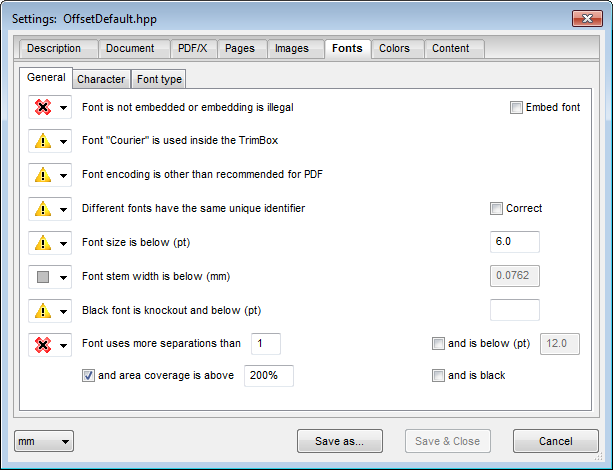

These are validation rules relating to the fonts used by the page contents. Respective error messages always refer to page objects.
Forms/comment fields are not checked.
The following tabs are found:
Font is not embedded or embedding is illegal
A font that is not embedded or a font that does not allow embedding cannot be printed reliably (TrueType).
This is remedied automatically when "Embed font" is enabled:
•Embed font
Embedding is with Adobe Acrobat and uses the installed system fonts.
Font "Courier" is used inside the TrimBox
Courier is often used as substitution font for missing fonts. Usage of the Courier font inside the Trim Box could indicate that an undesired font replacement has taken place.
Font encoding is other than recommended for PDF
The PDF specification contains strict rules with regard to encoding (e.g. WinAnsi or MacRoman) – in particular for TrueType fonts. Failure to comply with these recommendations can result in faulty font output.
Different fonts have the same unique identifier
Correct Type1 fonts have a UniqueID valid worldwide. Fonts can be printed incorrectly if a document contains different fonts with the same UniqueID.
You can enable "Correct".
Font size is below (pt)
Fonts that are too small are sometimes not legible when printed.
In some cases, letters with a narrow stem width cannot be printed in good quality.
Black font is knockout and below (pt)
In particular smaller black fonts are normally set to overprint when created (i.e. CMY channels lying below them are preserved) so that no fringes or flashes will occur.
Font uses more separations than
In particular smaller fonts with more than one color channel are problematic in printing because fringes or flashes can occur.
You can set this check item with the following criteria:
·Minimum number of separations
The action runs if the font is made up of at least this number of separations.
·"and is below (pt)"
The action runs only if the font is also smaller than the set value.
·"and area coverage is above"
The action runs only if the area coverage of the font is also above this value.
·"and is black"
The action runs only if the font also looks black. A black made up of the CMYK separations can be the unwanted result of color management. Colored fonts made up of several separations, on the other hand, do not trigger a warning.
Width of a character is not defined
A character with an undefined width is an indication of a font with a faulty encoding and normally produces impaired texts. This check should always be enabled.
Character is not defined in the embedded data/Character is defined several times in the embedded data/Character is defined incorrectly in the embedded data
Missing characters or those that are defined several times or incorrectly cannot be printed reliably or cannot be printed at all.
Character without glyph is not encoded as space
This occurs mainly in incorrectly embedded or incorrectly encoded fonts.
Multiple master font is used
Multiple master (MMType1) fonts create characters by calculating certain font parameters from templates. You should not use such fonts for printing.
OpenType font is used
OpenType fonts are an extension of the TrueType format and were introduced as late as PDF 1.6. OpenType fonts may not be understood by older output systems and are prohibited in PDF/X-1a:2003 and PDF/X-3:2003.
Type3 (user-defined) font is used
User-defined fonts are quite common and normally do not cause any print problems. You can enable this for information purposes.
TrueType font is used
TrueType fonts can cause print problems, in particular when their encoding does not comply with the PDF specification. The quality of these fonts is normally lower than that of Type1 fonts.
TrueType CID font is used
Checks whether the TrueType CID variant (Type0/CIDFontType2) is used. Acrobat Distiller often embeds European TrueType fonts as CID variant since these can be encoded better.
Type1 font is used
Fonts in standard Adobe Type1 format are quite common and normally do not cause any print problems. You can enable this for information purposes.
Type1 CID font is used
Fonts in standard Adobe Type1 CID format (Type0/CIDFontType0) are quite common and normally do not cause any print problems. You can enable this for information purposes.
This is where you can specify the names of fonts that, for example, tend to cause problems during output. You can also enable the option "Convert to graphics" to automatically convert the fonts.
HD Privacy Statement | Imprint | Prinect Know How